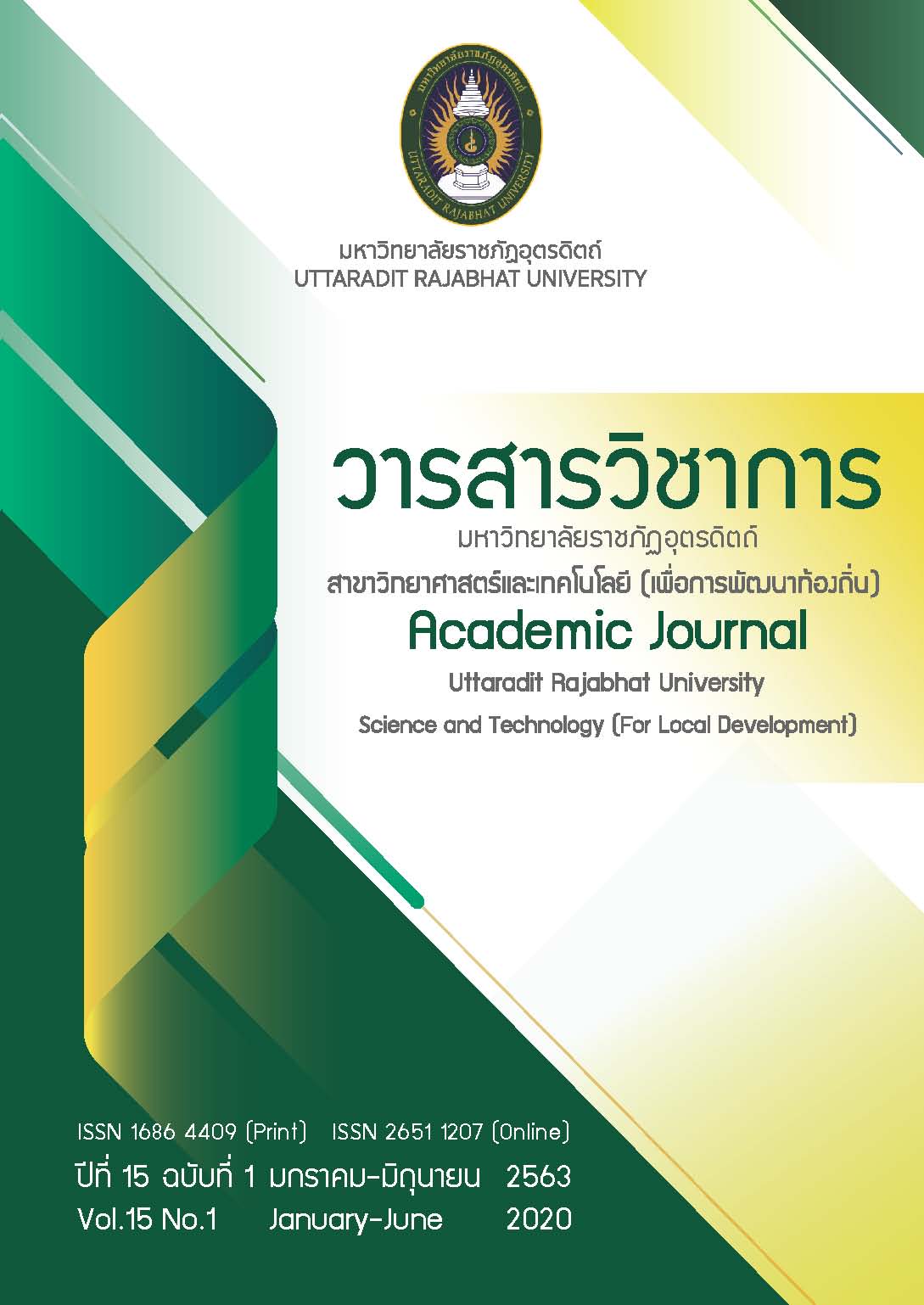รูปแบบการประเมินสภาผู้นำชุมชนจัดการตนเองเพื่อชุมชนน่าอยู่
Main Article Content
Abstract
This study had 3 significant objectives; 1)To study working condition and the methods of community leader council evaluation, 2) To develop community leader council evaluation model in terms of self-management for livable community, and 3)To try out community leader council evaluation model in terms of self-management for livable community. This research was divided in to 3 phases. The first phase was the study of working condition as well as the methods of community leader council evaluation by studying related document and research, interviewing, and meeting in order to brainstorm the ideas. The 69 key informants were the community leaders living in 14 Northern Thai provinces. The second phrase was conducted by developing evaluation model of community leader council in self-management for livable community. The Delphi method was applied in this phrase by using 17 experts. Then, the third phrase, trying out community leader council evaluation model in terms of self-management for livable community, was conducted in 2 villages by 2 groups of 20 assessors. The data were analyzed by using median and interquartile range.
The findings revealed as follows.1)Community leader council could work according to their roles and were succeed in village management. Furthermore, the community members had appropriate behavior in terms of health care. They had also life safety and better environment. However, there was no obvious evaluation model. Therefore, the evaluation model should be developed in order to get more information relating to administration for supporting the community leader council operation. 2)The development of community leader council in terms of self-management for livable community consisted of 9 elements; 1)The definition of evaluation, 2)The objective of evaluation, 3)The 4 aspects of evaluation consisted of community leader council management, input, and operational processes. Also, the operation outcome consisted of 16 indicators were evaluation 4)processes, 5)assessors, 6)evaluation instruments, 7)evaluation judgment, 8)evaluation results’ report, and 9)the usage of evaluation results. The experts considered the evaluation model appropriate and possible in terms of its factors (Mdn › 3.50, IQR ≤ 1.50). 3)Trying out the evaluation model of community leader council in self-management for livable community in 2 villages, the results confirmed that the evaluation results, according to each factor and indicator, were at the highest level. Besides, the assessors’ group considered the evaluation model possible. Its validity, propriety, and utility were at the highest level (x̄ = 4.70, S.D. = 0.45).
Downloads
Article Details
References
ฉัตรนภา พรหมมา. (2557).เอกสารประกอบการสอนรายวิชาระเบียบวิธีวิจัยและประเมินเพื่อพัฒนา
การศึกษา.อุตรดิตถ์.มหาวิทยาลัยราชภัฎอุตรดิตถ์.
(2561).รูปแบบการประเมินเสริมพลังการบริหารจัดการงานวิจัยและพันธกิจสัมพันธ์ มหาวิทยาลัยราช
ภัฎอุตรดิตถ์กับชุมชนท้องถิ่น.วารสารวิชาการมหาวิทยาลัยราชภัฎอุตรดิตถ์,13(2),1-12
ชนัดดา บุบผามาศ. (2557). การประเมินโครงการระบบโครงข่ายการเรียนรู้ไร้พรมแดนโรงเรียนในสังกัด สำนักงานเขตพื้นที่การศึกษามัธยมศึกษา เขต 8. (ศึกษาศาสตรมหาบัณฑิต), มหาวิทยาลัยศิลปากร,
ชัญญา อภิปาลกุล. (2545). รูปแบบการพัฒนาผู้บริหารสถานศึกษาเพื่อปฏิรูปการเรียนรู้ในสถานศึกษา SINTPAE MODEL(ฉบับสรุป). กรุงเทพมหานคร: สำนักงานคณะกรรมการการศึกษาแห่งชาติ.
ปรเมธี วิมลศิริ. (2560). เศรษฐกิจไทยปี 2560. ไทยพับลิก้า. สืบค้น 26 มกราคม 2561,
จาก https://thaipublica.org/2017/05/nesdb-q1-2560/
ปิยนาถ น่วมทอง.(2562).การพัฒนารูปแบบการประเมินการจัดการเรียนรู้แบบบูรณาการเพื่อทักษะชีวิต
สำหรับโรงเรียนขนาดเล็ก สังกัดสำนักงานคณะกรรมการการศึกษาขั้นพื้นฐาน.วารสารวิชาการ
มหาวิทยาลัยราชภัฎกาญจนบุรี,8(2),290.
ประเสริฐ บุญเรือง. (2555). การจัดการศึกษาตลอดชีวิต. วารสารการศึกษาตลอดชีวิต,1(1), 1-4.
เพ็ชชรี อ้นทองทิม. (2561).รูปแบบการประเมินการจัดการเรียนรู้เพศวิถีศึกษาบูรณาการในสถานศึกษาขั้น
พื้นฐาน.วารสารวิชาการบัณฑิตศึกษาและสังคมศาสตร์ มหาวิทยาลัยราชภัฏอุตรดิตถ์, 8(1), 87-89.
พัชราวดี ตรีชัย. (2552). การวิเคราะห์ความเป็นชุมชนเข้มแข็งของหมู่บ้านหนองกลางดงตำบลศิลาลอยอำเภอ สามร้อยยอดจังหวัดประจวบคีรีขันธ์. วารสารร่มพฤกษ์, 27(1), 126.
ราชกิจจานุเบกษา ฉบับกฤษฎีกา. (2542). พระราชบัญญัติการศึกษาแห่งชาติ พ.ศ.2542. กรุงเทพมหานคร: ศูนย์สารสนเทศสำนักงานปลัดกระทรวงศึกษาธิการ.
วจีพร สุขสมบูรณ์.(2561).รูปแบบการประเมินโครงการจัดการเรียนการสอนตามหลักสูตรกระทรวงศึกษาธิการ
เป็นภาษาอังกฤษ.วารสารวิชาการดุษฎีบัณฑิตทางสังคมศาสตร์,8(1),57-58.
วริฎฐา แก้วเกตุ. (2550). สภาองค์กรชุมชนรวมพลังสร้างความเข้มแข็งของชุมชน. สถาบันพัฒนาองค์กรชุมชน (องค์การมหาชน).
วิทยา จันทร์แดง. (2555). การพัฒนารูปแบบการบริหารจัดการชุมชนเข้มแข็งตามแนวปรัชญาเศรษฐกิจ พอเพียง ในเขตจังหวัดภาคกลางตอนบน. (วิทยานิพนธ์ปริญญาดุษฎีบัณฑิต). มหาวิทยาลัยราชภัฏว ไลยอลงกรณ์ ในพระบรมราชูปถัมภ์.
ศิริชัย กาญจนวาสี. (2554). ทฤษฎีการประเมิน. กรุงเทพมหานคร: สำนักพิมพ์แห่งจุฬาลงกรณ์มหาวิทยาลัย.
ศิริพร ศิริรัตน์. (2557). การประเมินโครงการเบญจวิถีนำทางสรรสร้างครอบครัวต้นแบบสายใยรักของศูนย์การ เรียนรู้โครงการสายใยรักแห่งครอบครัว จังหวัดราชบุรี. (ศึกษาศาสตรมหาบัณฑิต). มหาวิทยาลัย ศิลปากร.
ศูนย์คุณธรรมและสถาบันบัณฑิตพัฒนบริหารศาสตร์. (2559). สถานการณ์คุณธรรมของสังคมไทย.
สืบค้น 12 กุมภาพันธ์ 2561, จาก https://www.springnews.co.th/news/12277
สมุทร ชำนาญ. (2546). การพัฒนารูปแบบการบริหารโรงเรียนที่บริหารโดยใช้โรงเรียนเป็นฐาน. (วิทยานิพนธ์ ปริญญาดุษฎีบัณฑิต). มหาวิทยาลัยบูรพา.
สุพจน์ แสงเงิน และคนอื่นๆ. (2546). กระบวนการเรียนรู้ของชุมชนในการพัฒนาความเข้มแข็งของชุมชน ศึกษากรณีชุมชนแผ่นดินทองคอยรุตตั๊กวา. สำนักงานคณะกรรมการส่งเสริมวิทยาศาสตร์ วิจัย และ
นวัตกรรม
สมบูรณ์ ธรรมลังกา. (2556). รูปแบบการเสริมสร้างความเข้มแข็งของชุมชนโดยใช้ภูมิปัญญาท้องถิ่นเป็นฐาน ในจังหวัดเชียงราย. (ครุศาสตรดุษฎีบัณฑิต). มหาวิทยาลัยราชภัฎเชียงราย.
สำนักงานกองทุนสนับสนุนการสร้างเสริมสุขภาพ. (2552). ไขเคล็ดลับความสำเร็จบ้านหนองกลางดง.
สืบค้น 25 กันยายน 2560, จาก https://www.thaihealth.or.th/Content
อำนาจ ศรีรัตนบัลล์. (2560). ชุมชนน่าอยู่ระดับหมู่บ้าน. สืบค้น 15 มกราคม 2561,
จาก https://www.gotoknow.org/posts/652118
อำภา จันทรากาศ. (2543). ทุนทางสังคมที่ส่งผลต่อความเข้มแข็งของชุมชน. (ศึกษาศาสตรมหาบัณฑิต). มหาวิทยาลัยเชียงใหม่.


